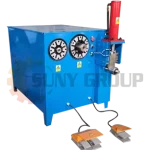Every day, millions of worn-out automobile motors reach the end of their lifespan. But before these motors can be recycled, a crucial process takes place — the dismantling of the rotor. Enter the automobile rotor dismantling machine — a powerful, precision-driven piece of equipment designed to separate the rotor and stator efficiently, safely, and profitably.
If you’ve ever wondered how this machine works or why it’s essential to modern motor recycling, you’re about to find out. Let’s explore the science, the engineering, and the sustainability impact behind this mechanical marvel.
1. What Is an Automobile Rotor Dismantling Machine?
An automobile rotor dismantling machine is a specialized device used to separate the rotor (the rotating core of an electric motor) from the stator (the stationary part). It’s a key step in recycling electric motors from vehicles, allowing valuable materials such as copper, aluminum, and steel to be recovered for reuse.
Unlike manual dismantling, which is slow, labor-intensive, and potentially dangerous, this automated system performs the same operation in a fraction of the time—often dismantling up to 200–300 motors per hour, depending on model and motor size.
automobile rotor dismantling machine
2. How Does It Work?
Step 1: Loading the Motor
The motor (from a car alternator, starter, or EV motor) is placed securely into the machine’s fixture. The clamping mechanism adjusts automatically to fit different motor sizes.
Step 2: Positioning and Centering
A servo-driven system aligns the motor perfectly with the cutting or pulling head to ensure accuracy. Misalignment could damage the copper or distort the stator core, so precision here is critical.
Step 3: Rotor Shaft Cutting or Pulling
Depending on design, the dismantling machine uses one of two main methods:
Cutting Type: A blade or saw cuts the rotor shaft cleanly from both ends.
Pulling Type: A hydraulic puller grips the rotor core and pulls it out from the stator housing.
Both methods ensure the copper windings remain intact for maximum recovery value.
Step 4: Material Separation
Once separated, the rotor (often containing steel laminations and copper) and stator components are automatically ejected into separate bins. This separation helps streamline downstream recycling processes.
Step 5: Safety and Automation
Advanced models feature PLC control systems, emergency stop functions, and automatic fault detection. Operators can monitor pressure, force, and cycle time via touchscreen interface for consistent results.
3.Key Features of a High-Quality Rotor Dismantling Machine
When investing in a dismantling system, look for:
Hydraulic Power System: Ensures strong and consistent pulling force.
PLC Touchscreen Control: Simplifies operation and improves efficiency.
Adjustable Fixtures: Handles diverse motor sizes.
Energy Efficiency: Lower power consumption means higher profitability.
Durable Blades and Pulling Rods: Extend service life and reduce downtime.
These features distinguish industrial-grade dismantling machines from entry-level alternatives.
An automobile rotor dismantling machine is more than just a tool — it’s a key enabler of circular economy in the automotive world. It combines mechanical strength with intelligent control, turning what was once a tedious process into a fast, profitable, and eco-friendly operation.
If your business handles end-of-life motors, integrating this machine could mean not just better recovery rates, but also a more sustainable, future-ready operation. In the race for greener industries, precision dismantling might just be your strongest advantage.
